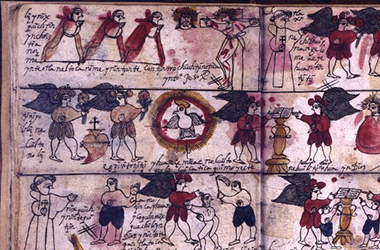Anthropologist Rewarded as She Finds a New Century for a New Spain Catechism
 |
|
A segment of 'The Little Doctrine,' a catechetical text included in the pictographic catechisms, and placed in a new historical context by Louise Burkhart.
|
ALBANY, N.Y. (November 25, 2015) — Pictographic catechisms traditionally have been ascribed to the 16th Century “spiritual conquest” of indigenous people in New Spain, “whether as evidence of mendicant friars’ ability to make Christianity appealing or of indigenous people’s agency in negotiating culturally appropriate styles of preaching,” writes anthropologist Louise Burkhart, professor and chair in the Department of Anthropology.
Burkhart goes on to write, however, “I aim to uproot this vestige of received wisdom and to recontextualize the texts within the later colonial period.”
She very likely has succeeded in her aim. Her essay on the subject, “The 'Little Doctrine' and Indigenous Catechesis in New Spain,” which appeared in the Hispanic American Historical Review, received this year’s Sixteenth Century Society and Conference's Harold Grimm Prize. It was presented to her at the Sixteenth Century Society and Conference's meeting on October 23 in Vancouver, British Columbia.
The paper traces the history of a particular catechetical quiz that has come to be known as The Little Doctrine. Widely used in colonial New Spain and directed at less “capable” Christians, its text makes its first appearance in works published in the 1630s by secular clergy posted in indigenous communities.
Renditions of this text in Spanish and in at minimum eleven indigenous languages vary somewhat in the number of questions and the exact questions asked, but a large number of shared questions, presented in the same order, allow the versions to be treated as variants of a single text. That this 17th Century text is a standard component of pictographic catechisms calls into question the conventional placement of these pictorial manuscripts into the evangelical tool kit of the 16th Century Franciscan and other friars.
Burkhart proposes a later origin for the genre, and theorizes its used may have been among the legitimating strategies pursued by indigenous elites in the 17th and 18th Centuries who sought to retain and regain lands and privileges. She suggests that pictographic catechisms supported elites' claims that their noble ancestors accepted Christianity immediately upon the arrival of the friars, learning doctrine in pictographic writing because they had not yet adopted alphabetic script.
She compares pictographic versions of the text with alphabetic ones and notes how indigenous artists transformed a text intended for “crude” native people into a testimony to the wisdom and faith of their picture-literate conquest-era ancestors.
Burkhart’s research was conducted in 2012-2013, when she held the Paul Mellon Senior Fellowship at the Center for Advanced Study in the Visual Arts, National Gallery of Art, Washington, DC.
![]() For more news, subscribe to UAlbany's RSS headline feeds
For more news, subscribe to UAlbany's RSS headline feeds
A comprehensive public research university, the University at Albany-SUNY offers more than 120 undergraduate majors and minors and 125 master's, doctoral and graduate certificate programs. UAlbany is a leader among all New York State colleges and universities in such diverse fields as atmospheric and environmental sciences, business, education, public health,health sciences, criminal justice, emergency preparedness, engineering and applied sciences, informatics, public administration, social welfare and sociology, taught by an extensive roster of faculty experts. It also offers expanded academic and research opportunities for students through an affiliation with Albany Law School. With a curriculum enhanced by 600 study-abroad opportunities, UAlbany launches great careers.


